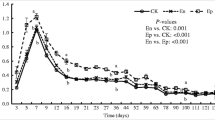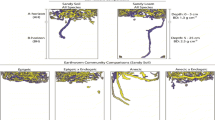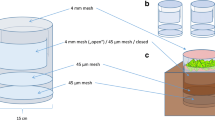Abstract
The aim of the study was to determine the effect of adding two tropical earthworm species, Rhinodrilus contortus and Pontoscolex corethrurus, to mesocosms on the availability of mineral N (NH4 + and NO3 − concentrations), soil microbial biomass (bio-N), and the decomposition rates of three contrasting leaf litter species, in a glasshouse experiment. The mesocosms were filled with forest soil and covered with a layer of leaf litter differing in nutritional quality: (1) Hevea brasiliensis (C/N=27); (2) Carapa guianensis (C/N=32); (3) Vismia sp., the dominant tree species in the second growth forest (control, C/N= 42); and, (4) a mixture of the former three leaf species, in equal proportions (C/N=34). At the end of the 97-day experiment, the soil mineral N concentrations, bio-N, and leaf litter weight loss were determined. Both earthworm species showed significant effects on the concentrations of soil NO3 − (p<0.01) and NH4 + (p<0.05). Bio-N was always greater in the mesocosms with earthworms (especially with R. contortus) and in the mesocosms with leaf litter of H. brasiliensis (6 µg N g−1 soil), the faster decomposing species, than in the other treatments (0.1–1.6 µg N g−1). Thus, earthworm activity increased soil mineral-N concentrations, possibly due to the consumption of soil microbial biomass, which can speed turnover and mineralization of microbial tissues. No significant differences in decomposition rate were found between the mesocosms with and without earthworms, suggesting that experiments lasting longer are needed to determine the effect of earthworms on litter decomposition rates.

Similar content being viewed by others
References
Anderson JM, Huish SA, Ineson P, Leonard MA, Splatt PR (1985) Interactions of invertebrates, micro-organisms and tree roots in nitrogen and mineral element fluxes in deciduous woodland soils. In: Fitter AH, Atkinson D, Read DJ, Usher MB (eds) Ecological interactions in soil. Blackwell Scientific Publications, Oxford, pp 377–392
Araujo Y (2000) Oligoquetos sob adição de liteira e sua relação com a disponibilidade de nitrogênio em solos de capoeira na Amazônia central. Master Thesis, INPA/UA, Manaus
Atlavinyte O, Lugauskas A (1971) The effect of lumbricidae on soil microorganisms. Ann Zool Ecol Anim Spec Publ 4:73–80
Barois I, Verdier B, Kaiser P, Mariotti A, Rangel P, Lavelle P (1987) Influence of the tropical earthworm Pontoscolex corethrurus (Glossoscolecidae) on fixation and mineralization of nitrogen. In: Boncini AM, Omodeo P (eds) On earthworms. Mucchi, Modena, pp 151–159
Barros E (1999) Effet de la macrofauna sur la structure et les processus physiques du sol de paturages degrades d’Amazonie. These de Doctorat, Université Paris 6
Barros E, Curmi P, Hallaire V, Chauvel A, Lavelle P (2001) Role of macrofauna in the transformation and reversibility of soil structure of an Oxisol during forest to pasture conversion. Geoderma 100:193–213
Barros E, Pashanasi B, Constantino R, Lavelle P (2002) Effects of land-use system on the soil macrofauna in western Brazilian Amazonia. Biol Fert Soils 35:338–347
Beck L, Höfer H, Martius C, Garcia M, Franklin E, Römbke J (1998) Soil fauna and litter decomposition in primary forest, secondary forest and polyculture systems in Amazonia—study design and methodology (SHIFT Project ENV 52) In: Lieberei R, Voss K, Bianchi H (eds) Proc 3rd SHIFT Worksh, Manaus, Brazil, pp 463–469
Blair JM, Parmelee RW, Allen MF, McCartney DA, Stinner BR (1997) Changes in soil N pools in response to earthworm population manipulations in agroecosystems with different N sources. Soil Biol Biochem 29:361–367
Blanchart E, Bruand A, Lavelle P (1993) The physical structure of Millisonia anomala (Oligochaeta: Megascolecidae) casts in shrub savanna soils (Côte d’Ivoire). Geoderma 56:119–132
Bohlen PJ, Edwards CA (1995) Earthworm effect on N dynamics and soil respiration in microcosms receiving organic and inorganic nutrients. Soil Biol Biochem 27:341–348
Brookes PC, Landman A, Pruden G, Jenkinson DS (1985) Chloroform fumigation and the release of soil nitrogen: a rapid direct extraction method to measure microbial biomass nitrogen in soil. Soil Biol Biochem 17:837–842
Decaens T, Lavelle P, Jimenez JJ, Escobar G, Rippstein G (1994) Impact of land management on soil macrofauna in the Oriental Llanos of Colombia. Eur J Soil Biol 30:157–168
Decaens T, Rangel AF, Asakawa N, Thomas J (1999) Carbon and nitrogen dynamics in ageing earthworm casts in grasslands of the Eastern Plains of Colombia. Biol Fert Soils 30:20–28
Fragoso C, Brown GG, Patrón JC, Blanchart E, Lavelle P, Pashanasi B, Senapati B, Kumar T (1997) Agricultural intensification, soil biodiversity and agroecosystem function in the tropics: the role of earthworms. Appl Soil Ecol 6:17–35
González G, Zou X, Borges S (1996) Earthworm abundance and species composition in abandoned tropical croplands: comparisons of tree plantations and secondary forests. Pedobiologia 40:385–391
Guerra RT (1988) Ecologia dos Oligochaeta da Amazônia. II Estudo da estivação e da atividade de Chibui bari (Glossoscolecidae, Oligochaeta), através da produção de excrementos. Acta Amazonica 18:27–34
Guerra RT, Asakawa N (1981) Efeito da presença e do número de indivíduos de Pontoscolex corethrurus (Glossoscolecidae, Oligochaeta) sobre a população total de microorganismos do solo. Acta Amazonica 11:319–324
Jennings DH (1989) Some perspectives on nitrogen and phosphorus metabolism in fungi. In: Boddy L, Marchant R, Read DJ (eds) Nitrogen, phosphorus and sulphur utilization by fungi. Cambridge University Press, Cambridge, pp 1–31
Jiménez JJ, Moreno AG, Decaens T, Lavelle P, Fisher MJ, Thomas RJ (1998) Earthworm communities in native savannas and man-made pastures of the Eastern Plains of Colombia. Biol Fert Soils 28:101–110
Lavelle P (1988) Earthworm activities and the soil system. Biol Fert Soils 6:237–251
Lavelle P (2000) Ecological challenges for soil science. Soil Sci 165:73–86
Lavelle P, Pashanasi B (1989) Soil macrofauna and land management in Peruvian Amazonia (Yurimaguas, Loreto). Pedobiologia 33:283–291
Lavelle P, Barois I, Cruz I, Fragoso C, Hernandez A, Pineda A, Rangel P (1987) Adaptive strategies of Pontoscolex corethrurus (Glossoscolecidae, Oligochaeta), a peregrine geophagous earthworm of the humid tropics. Biol Fert Soils 5:188–194
Lavelle P, Bignell D, Lepage M, Wolters V, Roger P, Ineson P, Heal OW, Dhillion S (1997) Soil function in a changing world: the role of invertebrate ecosystem engineers. Eur J Soil Biol 33:159–193
Lee K (1985) Earthworms: their ecology and relationships with soils and land use. Academic Press, New York
Luizão FJ (1985) Influência da calagem e adubação orgânica na mesofauna e em algumas propriedades físicas de um Latossolo Amarelo textura argilosa. Rev Bras Ci Solo 9:81–84
Luizão FJ, Schubart HOR (1987) Litter production and decomposition in ‘terra firme’ forest of the Central Amazonia. Experientia 43:259–285
Maynard DG, Kalra YP (1993) Nitrate and exchangeable ammonium nitrogen. In: Carter MR (ed) Soil sampling and methods of analysis. Lewis Publishers, New York, pp 25–38
Palm CA, Sanchez PA (1990) Decomposition and nutrient release patterns of the leaves of three tropical legumes. Biotropica 22:330–338
Parle JN (1963) A microbial study of earthworm casts. J Gen Microbiol 31:13–22
Pashanasi B, Melendez G, Szott L, Lavelle P (1992) Effect of inoculation with endogeic earthworm Ponstoscolex corethrurus (Glossoscolecidae) on N availability, soil microbial biomass and the growth of three tropical fruit tree seedlings in a pot experiment. Soil Biol Biochem 24:1655–1659
Römbke J, Verhaagh M (1992) About earthworm communities in a rain forest and an adjacent pasture in Peru. Amazoniana 12:29–49
Scheu S (1987) Microbial activity and nutrient dynamics in earthworm casts (Lumbricidae). Soil Biol Biochem 5:230–234
Shaw C, Pawluk S (1986) Faecal microbiology of Octolasion tyrtaeum, Aporrectodea turgida and Lumbricus terrestris and its relation to carbon budgets of three artificial soils. Pedobiologia 29:327–339
Wardle D, Lavelle P (1997) Linkages between soil biota, plant litter quality and decomposition. In: Cadisch G, Giller KE (eds) Driven by nature. CAB International, Wallingford, pp 107–125
Wilkinson L (1996) SYSTAT 6.0 for Windows. SPSS, Chicago, Illinois
Acknowledgements
Funding was provided by projects PNOPG/CNPq 400033/99-2 and PPI 1-3200 INPA. Dr. Ilse Walker is thanked for the use of laboratory facilities in part of the work.
Author information
Authors and Affiliations
Corresponding author
Rights and permissions
About this article
Cite this article
Araujo, Y., Luizão, F.J. & Barros, E. Effect of earthworm addition on soil nitrogen availability, microbial biomass and litter decomposition in mesocosms. Biol Fertil Soils 39, 146–152 (2004). https://doi.org/10.1007/s00374-003-0696-0
Received:
Accepted:
Published:
Issue Date:
DOI: https://doi.org/10.1007/s00374-003-0696-0




